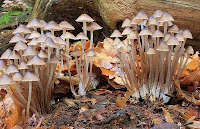Although I now know a bit more about mushrooms, I wish I had learned more about them back then. I might have appreciated them more. There is a lot most people do not know about these strange beings. In fact, mushroom "plants," for the most part, lead secret lives.
I referred to mushrooms as "plants" in the preceding sentence, putting the word in quotation marks because they are not classified by biologists as being in the plant kingdom. They do not have green chlorophyll to convert sunlight into sugar through photosynthesis, as do trees, shrubs, and grasses. Instead, mushrooms are a sophisticated form of fungi, serving a role in the creation of rich soil. What we see above ground are the reproductive bodies occasionally "flowering" up from the base below ground, producing spores rather than seeds. (Perhaps it was the sudden appearance of mushrooms at night that led to mushrooms having been associated with fairies.)
I did omit one detail in my confession about being afraid to eat cooked mushrooms: As kids, we did not usually call them "mushrooms." We said "toadstools" instead. That name engaged my childhood curiosity. I think I secretly hoped that I might catch sight of a small toad comfortably seated on top of one of the "stools," even though toads were farther and few between than mushrooms where we lived. (Is there any end to the things a child wishes for?)
Having now gotten well beyond my childhood caution about possibly dying by poisoned mushroom, I have a couple of times picked one, but not to cook it. Instead, I wanted to get a closer look at the underside of the cap. Hidden there are what seem like a hundred thin leaves radiating out from the center, all looking like the fanned pages of a book.
In illustrations in children's books, mushrooms have been part of the imagined world of exotic animals, elves, and fairies. When mushrooms rise from the rim of the unseen body below ground they sometimes form a rough circle, imagined to be a "fairy ring."
As a child, I never really believed in fairies. Nevertheless, I do like to occasionally think about silent mushroom bodies living their own lives below the surface of the ground. Millions of them, all around the Earth. Silently living and waiting. Unhurried. Waiting not for us, but for the right conditions to reproduce. Just as they did for over half-a-billion years before there were any humans around to hurry, and to believe.
~~~
Have you ever been surprised by suddenly appearing mushrooms? Where?
(The photo of the pair of mushrooms is by Ezhuttukari.
The photo of the clusters of small mushrooms is by Stu Phillips.
Both are used under Creative Commons Attribution-Share Alike 3.0 Unported licenses.)






